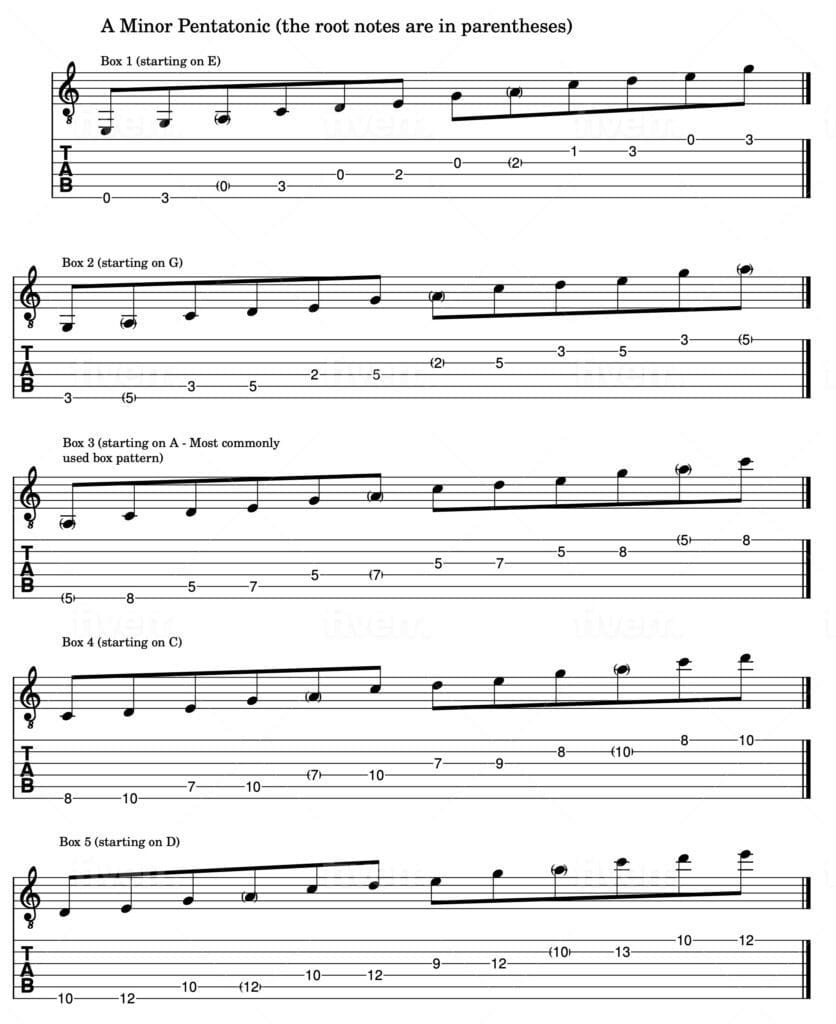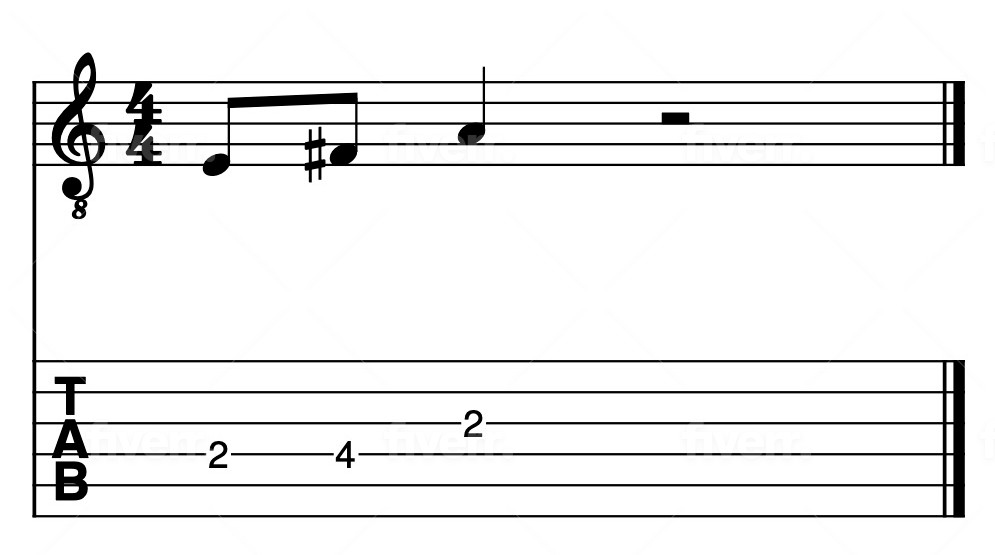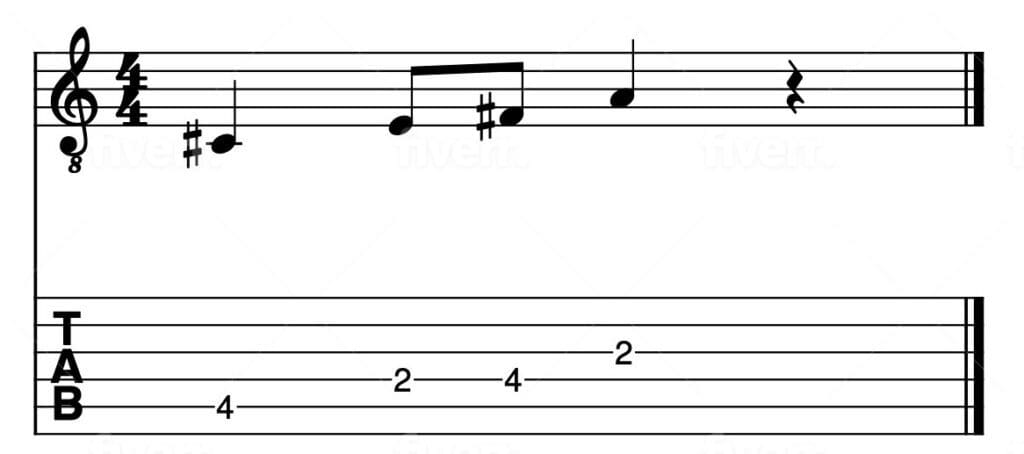Listening to great masters of improvisation on the guitar is an eye-opening experience. Ideas seem to just flow out of them while making it all look so easy! It is something to aspire to, and easily within reach for any guitar player.
In this piece, we will take a look at some simple ideas and concepts to get you started with improvisation. As you will read and hear, getting started is not as hard as it seems!
Start with a couple of scales
For most guitarists, the easiest place to start is the major and minor pentatonic scales because they’re easy to learn and use. Most of them can be played in two-note-per-string box patterns and are very common in all popular genres.
Here are the box patterns for the A major pentatonic scale. Note that all the root notes (or in this case, all the “A” notes) are highlighted in parentheses:

And here are the box patterns for the A minor pentatonic scale (again, the root notes are highlighted in parentheses):

Pay close attention to where your roots are. These are the notes that tell you what key your scale will be in. So if you wanted to play the same scale in Cm instead of Am, just take a box and move it to where the note C will correspond with the position of the root notes in the box. Play the same fingering pattern, and voilà! Same pattern, different key!
Start by keeping it simple
Now that you have those scales down, it’s time to apply them to some playing. When starting out, simplicity is key. One of the most helpful exercises for students is to set limitations, allowing them to focus on just a few notes, rather than the entire scale. This removes some of the choice fatigue of using too many notes, especially when starting out, and helps prevent just playing the scale up and down. We want to be conversational, and not sound like an exercise.
To start out, why not just pick two strings to play on? Please have a look and listen at the following example:

As you can see, all of the licks are played on just the high E and B strings, and they all belong to the same pentatonic box (box 3 of the pentatonic minor scales noted earlier). The rhythms are also simple, focusing more on notes and phrases than flash (the flash does come later though!).
The notes do work over every chord in the progression, so it’s impossible to hit a bad one! By doing this, you’ll start to get a feel and ear for where certain notes work.
Once you feel like you’ve exhausted all possibilities, try adding a third string to the mix, changing string groupings, or using a different box pattern. So many possibilities!
Get some motifs happening
When we improvise, we’re conversing with ourselves and the other musicians. Much like speaking, we want to use phrases that work well and make sense and work well with each other. One technique that allows you to construct phrases that work well together is using motifs.
A motif is a repeated musical idea that becomes recognizable because of that repetition. They can also be done either rhythmically or melodically.
A rhythmic motif is just a repeated rhythm. They can employ repeated notes and different notes, but the rhythm is the same from phrase to phrase. Here’s an example of a simple rhythm:

Looks easy enough. But now, let’s apply that with some notes:

As you can hear, that simple rhythm is the germ of an idea for four small phrases. And because the rhythm is the same, it becomes recognizable and ear-catching to the listener. Not only that, but it sounds more like a coherent musical idea. But for you, you were able to improvise four short phrases with ease!
Now let’s apply the same concept to the melody. Instead of a simple rhythm, here’s a simple line with three ascending notes:

You can now use that as the germ of an idea and choose to play your next couple of phrases using nothing but three ascending notes, such as this:

Now, you can apply one, you can apply the other, but how about both? Of course, you can! Here is an example of a phrase using a simple rhythm and four descending notes:

Now, let’s construct a phrase using that idea:

Just using those two tools, we now have a line that’s easy for the player to construct and play on the fly and something that catches the audience’s ear because it’s musical glue; it just sticks with them!
Follow the chords
When we’re starting out with improvisation, we tend to pick one scale, one box, and stick with it the whole time. Hey, the notes work and I don’t have to move around too much, this is easy… right?
Yes, it is! And the joy of playing this way almost ensures that you have no bum notes that stick out like a sore thumb.
However, if we want to level up our playing, you can change scales when the chords in the song change. It’s also easier than you think!
All scales on the guitar are pattern-based. The fingerings for a major scale are identical from key to key, the only thing that changes is where you are on the neck when you play them. That gives us guitar players an advantage over piano and horn players, who have to learn different combinations of notes on their instruments. For us, once we’ve learned one scale, we’ve technically learned 12!
So let’s have a simple motif going over some major pentatonic scales. You’ll notice that the roots of each lick are in parentheses:

We’re using box 2 of the major pentatonic scale (demonstrated in the first picture); however, the first bar is A pentatonic, the second is D pentatonic and the third is E pentatonic. The licks are the same as far as the order of notes, rhythm, etc. All we’re doing is taking it and moving it to different roots for the different chords. And just like that, you’ve upped your game!
How to practice these concepts
The most ideal way to practice improvisation is by playing over backing tracks. There is a wealth of those available online (just search for “Backing Tracks” on YouTube, and you’ll see what I mean) in different styles and keys. For the very first time, start out with a slow tempo of 60 bpm and tackle faster melodies by making small tempo steps once you feel comfortable.
A better approach would also be to record yourself improvising over backing tracks. This gives you a chance to hear what you did while in the moment, point out things that you really liked, and pick out things that you can improve on.
So, practice those scales, work with these concepts, and soon you’ll be on your way towards improvisational glory!
Did you record some ear-catching phrases, and you want to keep your ideas safe? Try our Guitar2Tabs App to transcribe them.

